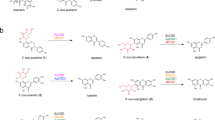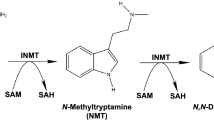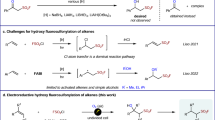Abstract
THE carcinogenicity of 2-acetylaminofluorene (I) administered orally to rats, was first reported in 1941 by Wilson, DeEds and Cox1. Subsequent studies showed that the free amine (II) was substantially as carcinogenic in this species as the acetyl derivative2. The values for LD 50 on the basis of millimoles per kgm. also were found to be essentially the same3. It was then postulated that the free amine may be the essential carcinogen and that deacetylation is a necessary prelude to carcinogenesis4. Studies in vivo with 2-acetylaminofluorene labelled with carbon-14 in the ω-position5 revealed that deacetylation did indeed occur6,7. In subsequent experiments in vitro the ability of rat liver slices and homogenates to deacetylate 2-acetylaminofluorene was demonstrated8,9. Thus, N-derivatives of 2-aminofluorene that are difficult to hydrolyse to the free amine should be less carcinogenic than those that are easily hydrolysed. It is true, of course, that if a substituent renders the compound non-absorbable from the gut it would not be carcinogenic, even though it was hydrolysed readily both in vivo by liver enzymes, and in vitro by acids. On the other hand, derivatives that are converted to 2-aminofluorene by reactions other than hydrolysis would be carcinogenic.
This is a preview of subscription content, access via your institution
Access options
Subscribe to this journal
Receive 51 print issues and online access
$199.00 per year
only $3.90 per issue
Buy this article
- Purchase on Springer Link
- Instant access to full article PDF
Prices may be subject to local taxes which are calculated during checkout
Similar content being viewed by others
References
Wilson, R. H., DeEds, F., and Cox, A. J., Cancer Res., 1, 595 (1941).
Weisburger, E. K., and Weisburger, J. H., in Vol. 5 ‘Advances in Cancer Research’, edit. by Greenstein, J. P., and Haddow, A., 361 (Academic Press Inc., New York, 1958).
Newell, M. P. (in preparation).
Ray, F. E., and Argus, M. F., Cancer Res., 11, 783 (1951).
Ray, F. E., and Geiser, R. C., Cancer Res., 10, 616 (1950).
Morris, H. P., Weisburger, J. H., and Weisburger, E. K., Cancer Res., 10, 620 (1950).
Weisburger, J. H., Weisburger, E. K., and Morris, H. P., J. Nat. Cancer Inst., 11, 797 (1951).
Gutmann, H. R., and Peters, J. H., J. Biol. Chem., 211, 63 (1954).
Weisburger, J. H., Biochim. et Biophys. Acta, 16, 382 (1955).
Westfall, B. B., J. Nat. Cancer Inst., 6, 23 (1945).
Morris, H. P. (in preparation).
Gutmann, H. R., and Peters, J. H., Cancer Res., 13, 415 (1953).
Hirs, C. H. W., J. Amer. Chem. Soc., 71, 1893 (1949).
Strasburger, J., Ber., 16, 2346 (1883).
Rombach, L. H., and MacGregor, I. R., J. Org. Chem., 19, 428 (1954).
Campbell, N., Anderson, W., and Gilmore, J., J. Chem. Soc., 466 (1940).
Author information
Authors and Affiliations
Rights and permissions
About this article
Cite this article
ARGUS, M., RAY, F. Possible Relation between Carcinogenicity and Ease of Hydrolysis in vitro of Derivatives of 2-Aminofluorene. Nature 184, 2018–2019 (1959). https://doi.org/10.1038/1842018a0
Issue Date:
DOI: https://doi.org/10.1038/1842018a0
Comments
By submitting a comment you agree to abide by our Terms and Community Guidelines. If you find something abusive or that does not comply with our terms or guidelines please flag it as inappropriate.



